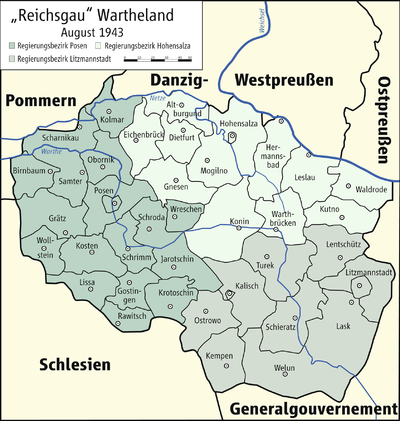Welun district

Welun district was the name of a German administrative unit in occupied Poland (1939–45) during the Second World War .
Prehistory (1793 to 1807)
After the Second Partition of Poland from 1793 to 1807, the area around the western Polish city of Wieluń temporarily belonged to the Prussian Province of South Prussia as a separate district of Wielun .
Administrative history
At the beginning of the Second World War , German troops occupied the western Polish powiat Wieluń , the district town of Wieluń was captured on September 2, 1939.
On October 26, 1939, the powiat was annexed to the German Reich under the name Landkreis Wielun , which, as a unilateral act of violence, was ineffective under international law. The district became part of the administrative district Kalisch (from 1941: administrative district Litzmannstadt) in the Reichsgau Wartheland .
The seat of the German District Office was the district town of Wieluń.
The name of the district was subsequently changed several times (on April 1, 1940 in the district of Welun , on May 21, 1941 in the district of Welungen and on September 24, 1942 again in the district of Welun ).
On November 20, 1939, small parts of the Radomsko powiat were incorporated as part of a border straightening from the neighboring Generalgouvernement to the east .
On July 1, 1940, part of the rural community Biała was given to the neighboring district of Lask .
On October 1, 1943, part of the rural community Konopnica was given to the neighboring district of Schieratz .
The German occupation ended with the invasion of the Red Army in January 1945.
politics
Land Commissioner
- 1939 : Herbert von Oelffen ( substitute )
- 1939 : Oldwig von Natzmer († 1942)
District administrators
- 1939–1942: Oldwig von Natzmer
- 1943–1945: Christoph Hesse (* 1910) ( acting )
Municipal structure
The district of Welun was divided into a township ( Wieluń ) and 32 rural communities, which were grouped together in administrative districts .
size
The district of Welun had an area of 2101 km² (1939).
population
The Welun district had in 1941: 268,010 mostly Polish inhabitants.
Between December 1, 1939 and December 31, 1943, the German occupation authorities expelled over 35,000 Poles from the area and deported and murdered the Jewish population.
The temporarily settled Germans (16,506 people in 1942, about 7% of the population) fled again towards the end of the German occupation.
Place names
At first there were “wild” Germanizations by the local occupation authorities. On May 18, 1943, all places with a post or train station were given German names, mostly phonetic adjustments, translations or free inventions.
List of cities and administrative districts in the district of Welun:
| Polish name | German name (1939-1945) | Polish name | German name (1939-1945) |
|---|---|---|---|
| Bolesławiec | Bolkenburg | Ostrówek |
1939–1943 Osterwerder 1943–1945 Eiland |
| Brzeźnica | Bern Valley | Pajęczno |
1939–1940 Peinstett 1940–1943 Pfeilstett 1943–1945 Pfeilstätt |
| Chróścin | brushwood | Praszka | Praschkau |
| Czastary | 1939–1943 Wildbad 1943–1945 Wildenbach |
Praszka | Praschkau |
| Działoszyn | Dill Valley | Radoszewice |
1939–1943 Wolfshag 1943–1945 Radenhag |
| Dzietrzkowice | Dieterwald | Rudniki | Ore smelter |
| Galewice | Gallwiese | Rząśnia |
1939–1943 Ransau 1943–1945 Ronsau |
| Kamionka | Steinerdorf | Siemkowice | Seed ground |
| Kiełczygłów | 1939–1943 Keilerkopf 1943–1945 Keilerbach |
Skomlin |
1939–1943 Kemmel 1943–1945 Schommeln |
| Konopnica | Hemp hut | Skrzynno | Sink field |
| Kraszewice | 1939–1943 Schöngrund 1943–1945 Schöngrunden |
Sokolniki | Falkenhof |
| Kurów | Kurfeld | Starzenice | Old willow |
| Kuźnica Grabowska | Schmiedenau | Sulmierzyce |
1939–1943 Sulmingen 1943–1945 Sulmers |
| Lututów | 1939–1943 Landstett 1943–1945 Landstätt |
Wieluń |
1939–1940 Wielun 1940–1941 Welun 1941–1942 Welung 1942–1945 Welun |
| Mierzyce | 1939–1943 Merzendorf 1943–1945 Marchendorf |
Wieruszów |
1939–1943 Wieruschau 1943–1945 Weruschau |
| Mokrsko | 1939–1943 Moker 1943–1945 Mockersfeld |
Wydrzyn | Otternhof |
| Naramice | Armenau | Zamoście | Niederbrück |
Web links
- Landkreis Welun administrative history and the district administrators on the website territorial.de (Rolf Jehke), as of August 19, 2013.
Individual evidence
- ↑ Litzmannstädter Zeitung : New district administrator for the Welun district solemnly committed , 26th year / no. 147, online .